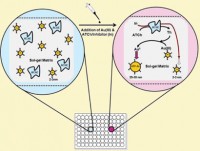A paper-based colorimetric dipstick bioassay that can detect low levels of pesticides has been developed by John Brennan and colleagues at McMaster University in Hamilton, Canada.
You can access the paper via the Analyst homepage.
Organophosphate pesticides can be toxic to both humans and animals as they inhibit important enzymes such as acetylcholinesterase (AChE) in the nervous system. They are still in widespread use so there is a need for a simple method to detect their residues. Now, Brennan’s team has created a gold nanoparticle-based dipstick test to identify inhibitors of the acetylcholinesterase enzyme that would be easy to use for in-field applications.
Brennan says he hopes to develop this system by ‘integrating the various reagents involved in the assay into a single lateral flow device, which should avoid the need for adding external reagents’. His group are also ‘investigating other enzymes that are known to support catalytic growth of gold nanoparticles to further evaluate this sensor platform’.
To read the full story, head to Highlights in Chemical Technology.











